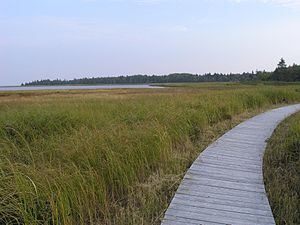Kouchibouguac National Park
| Kouchibouguac National Park Parc national de Kouchibouguac (French) |
|
|---|---|
|
IUCN category II (national park)
|
|

Boardwalk over a salt marsh
|
|
|
Location of Kouchibouguac National Park in Canada
|
|
| Location | Kouchibouguac, New Brunswick, Canada |
| Coordinates | 46°50′59″N 64°58′01″W / 46.84972°N 64.96694°WCoordinates: 46°50′59″N 64°58′01″W / 46.84972°N 64.96694°W |
| Area | 238 km2 (92 sq mi) |
| Established | 1969 |
| Visitors | 159,398 (in 2015-16) |
| Governing body | Parks Canada |
Kouchibouguac National Park ('kʊʃ.ɘ.boʊˌkwæk) is located on the east coast of New Brunswick, in Kouchibouguac. The park includes barrier islands, sand dunes, lagoons, salt marshes and forests. It provides habitat for seabirds, including the endangered piping plover, and the second largest tern colony in North America. Colonies of harbour seals and grey seals also inhabit the park's 25 kilometres (16 mi) of sand dunes. It is also home to the extremely rare and fragile Gulf of St. Lawrence aster, though in 2006, storms eradicated most of the asters' colonies. The park's size is 238 square kilometres (92 sq mi). Recreational activities in the park include swimming, cycling and hiking. In recent news, the park has reported sightings of the fisher marten in the area, making it one of the few places in New Brunswick that have fisher populations. The park's various public activities attract thousands of visitors each year. Kouchibouguac offers a range of activities, from a river adventure in a voyageur-style canoe, to going seal watching, to a talk about Mi'kmaq band governments. The park is also home to the popular Kelly's Beach.
The park was founded in 1969 in order to set aside sensitive sand dunes and bogs. The rules of the time dictated that all permanent residents had to be removed for a park to be created. These residents were mostly Acadians, whose ancestors had been deported. As a result, Parks Canada encountered great difficulty expropriating land from numerous land owners who lived in seven communities (approximately 215 families, including over 1200 individuals). These seven communities were Claire-Fontaine, Fontaine, Rivière au Portage, Kouchibouguac, Guimond Village, Cap St-Louis, and Saint-Olivier. The ,residents were generally seen as so poor that government officials believed they would benefit from having to start their lives again elsewhere. The government patronizingly created courses so that people might lead more productive lives. Government officials believed that they were rehabilitating the people by forcing them to move. But the residents resisted this move shutting down the park on several occasions. The most notable of these was Jackie Vautour, whose home was buldozed in 1976, but who returned to squat there two years later, where he still remains. Vautour's decades-long struggle has turned him into a folk hero.
...
Wikipedia

